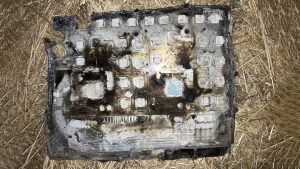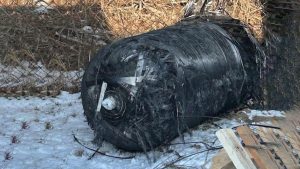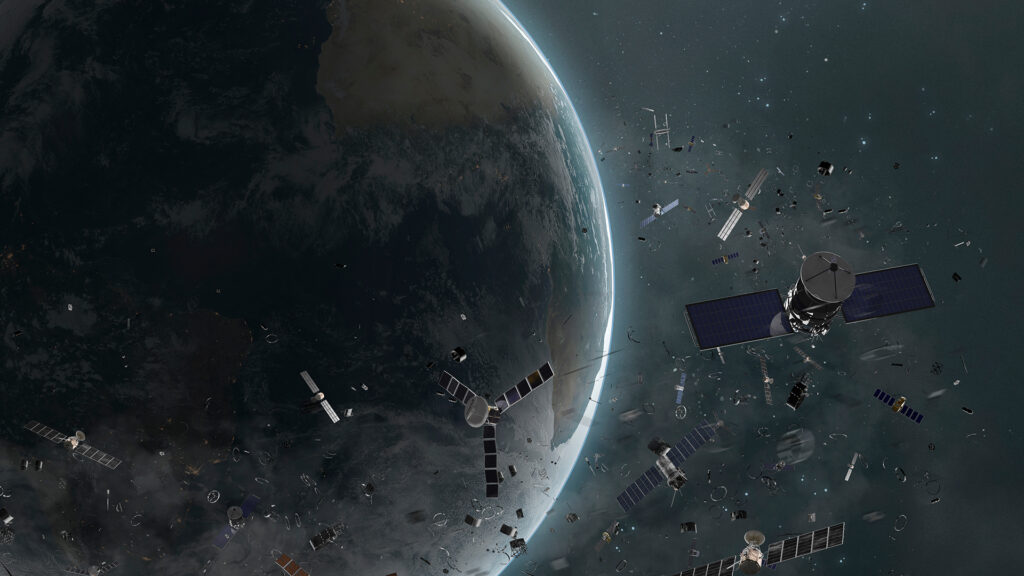As the issue of space debris becomes more pressing, Kseniia Hryshchuk, Space Environment Engineer at 3S-Northumbria, considers how we can create a more sustainable space environment.
What is space sustainability? This is an open-ended question. In theory, it refers to ensuring that we remain able to conduct space activities indefinitely without degrading the orbital environment. In practice, it is often used loosely, with little clarity or accountability, and it is becoming a bit of a buzz phrase.
Space sustainability primarily deals with the impact of human activities in space. So, anything from launch vehicles to satellites and space stations, and what goes into making, maintaining and safely disposing of them. One possible way to track the impact is by transferring the Life Cycle Assessment (LCA) approach from other industries to the space domain, which is something the European Space Agency (ESA) together with EU’s European Commission have started to push for.1,2 LCA encompasses many things from sustainable use of resources that go into manufacturing a spacecraft (such as materials, transportation, manufacturing techniques, propellants, etc.) to planning and guiding its end of life, like returning reusable rocket stages after launch or deorbiting satellites after they have served their purpose. The idea is to be able to better understand the trade-offs the space industry could be making to meet certain environmental metrics.
But sustainability is not just about manufacturing and decommissioning practices, it is also about preservation of space, especially near-Earth space, for use by future generations.
Space debris is the zeitgeist of the space domain
Orbital debris is perhaps the most palpable threat to space sustainability. For decades, humans have been launching objects into near-Earth orbit without fully acknowledging that this orbital space, which we rely on for essential services like communication, navigation, and Earth observation, is far from infinite. Today, there are around 13,000 active satellites orbiting the Earth,³ which may already seem overwhelming.
But that’s only part of the picture. Thousands of defunct satellites, spent rocket stages, and fragments from past collisions or breakup events, even paint flecks are also circling the planet. Many of these objects are uncontrolled, tumbling through space and occasionally colliding, creating more debris pieces. ESA estimates that there are over 141 million debris objects (larger than 1mm) in Earth orbit.⁴ All this debris shares the same environment as the satellites we depend on daily. A stark example is the recent 2024 breakup of Intelsat 33e in geostationary orbit, which alone initially produced over 1000 pieces as tracked by ExoAnalytic Solutions Inc.⁵
The situation is even more concerning in low Earth orbit (LEO), where we are seeing a rapid expansion of satellite constellations like Starlink, OneWeb, Kuiper, Qianfan, and Cosmos. The reality is that since the Covid-19 pandemic, we have entered an era of mega-constellations. Satellites are being deployed at an unprecedented pace, leading to dramatically increased orbital traffic, and yet there appear to be few significant obstacles in obtaining launch licenses and very few attempts are made to question the need for these vast constellations. What’s more concerning is the lack of public discussion around what long-term sustainability implications these carry. Starlink alone now accounts for approximately two thirds of all active satellites.³
The root of the problem is lack of enforceable regulation. The 1967 Outer Space Treaty didn’t address debris.⁶ It set out broad principles of sensible conduct. Reminiscent of the Hippocratic Oath, “do no harm”, states that ratified the Outer Space Treaty agreed to avoid harmful interference. However, in practice, there are no enforceable international laws requiring states or companies to responsibly manage defunct satellites, so long as they do not intentionally damage the assets of others. National regulators issue licenses with varying standards, and few seem to ask tough questions about cumulative orbital impact.
Europe is trying to lead by example when it comes to responsible practices in the space domain. ESA has taken a firm stance on the issue of space sustainability and has a dedicated Clean Space office that has been leading the Zero Debris Approach initiative since 2022.⁷ To mitigate the numbers of orbital debris, they have proposed that all satellites in low Earth orbit must deorbit within five years of end of mission with a 90% success rate,⁸ building on the UN’s COPUOS (Committee on the Peaceful Uses of Outer Space) previous 25-year guideline.⁹
At the core of this initiative is ESA’s Zero Debris Charter10,11, for which 3S Northumbria was one of the first signatories. Our engineers are also active contributors towards the development and drafting of ESA’s Zero Debris Booklet.12 The idea behind it is to welcome voluntary contributions from industry and academia towards making practical guidelines that aim to shift space sustainability from aspirational to actionable. Responsible mission design, effective collision avoidance, and standardised end-of-life disposal are just the first steps and above all are preventative measures that do not necessarily solve the issue of what is already in orbit. Without binding international agreements and stronger national oversight, operators will continue to act in their own interest, and the risk to the orbital environment and humanity will only grow.
Coming back to the five-year demise guideline, SpaceX’s Starlink satellites follow this principle as per FCC’s requirement, and we witness re-entries daily. But is this really the best solution? While many Starlinks burn up on their way down, there are confirmed cases of debris surviving and reaching the ground.16 Aside from the immediate risk to human life by direct hit (although currently low), there is another open-ended question of what impact is this course of action having on our atmosphere and by extension climate.


An important study17 that was conducted at the start of mega-constellations rise in 2023 showed that we are already seeing significant presence of metals such as aluminium, copper, lead and lithium in the stratosphere, that are undoubtably originated upon re-entry and ablation of satellite materials. The field of atmospheric impacts of space debris re-entry is still developing, but the outcomes are already worrying. Regardless of whether we can or cannot definitively say if re-entering satellites will lead to serious environmental impacts, we can see that we have already created an unnatural abnormality. Only time will show what price we will end up paying for it.
This, of course, sparks further debate around ‘design for demise’, which inevitably became a companion effort to the five-year deorbit guideline. Compliant manufacturers face the challenge of building LEO-bound satellites capable of deorbiting at the end of their mission, with the understanding of underlying design trade-offs.

What about tackling the already-existing debris?
Proponents of ISAM (In-orbit Servicing, Assembly, and Manufacturing) often refer to the car analogy: you don’t send a car to the junkyard when it runs out of fuel or needs new brake pads; you refuel and repair it to get the most use out of it. This is perfectly sound logic. Why deorbit an otherwise functional satellite due to a minor failure or lack of propulsion when it could be maintained or refuelled in orbit?
In addition to in-orbit servicing, ISAM is seen as a potential contender to deliver an ADR (active debris removal) solution. The challenge, however, is that no off-the-shelf technology currently exists to capture a tumbling, non-cooperative object in orbit. Non-cooperative docking is extremely complex as it involves modelling complex orbital dynamics, designing robust docking systems that can withstand impact forces, and managing numerous technical variables we’re not yet fully equipped to handle.
All objects travel at very high relative speeds in LEO. So, an uncontrollably tumbling piece of debris carries serious implications. Ironically, compared to other orbital regimes, LEO is where debris removal is realistically most needed as this is where most active satellites currently operate.
The end goal of using ISAM for ADR would be for a servicing satellite to dock with a piece of debris, manoeuvre with it to a lower orbit, and release it, thereby accelerating its demise. Companies like Astroscale are working on demonstration missions known as cooperative docking,18 where the client satellite still has thrust capacity and can position itself for docking with a servicing vehicle. However, if a satellite still has propulsion and can communicate well enough to assist in docking, it likely has the capability to deorbit itself, negating the need to be deorbited through means of complex docking and at the expense of the propulsion capacity of a servicer satellite.
Several missions are planned to launch before the end of the decade to demonstrate cooperative docking on orbit. One example is ClearSpace-1, a mission by ClearSpace, OHB SE, and ESA, which will attempt to capture a defunct ESA satellite, PROBA-1, in LEO with a set of robotic claws.19 The servicer will carry enough fuel for up to three capture attempts and will deorbit itself with the target in a controlled but passive manner. D-Orbit is also preparing the RISE mission, aimed at demonstrating rendezvous and docking with a geostationary satellite.20 The European Commission on behalf of the EU has announced plans to launch a pilot ISOS (In-Space Operations and Services) mission by 2030, which is expected to test docking with cooperative prepared and non-prepared targets.21
Still, the real test for ISAM in ADR will be dealing with uncontrolled, non-cooperative debris which is something we do not yet have the capability to conduct safely. Attempting to catch high-speed debris with a robotic arm could easily result in a collision, creating more debris. While ISAM technology is far from being ready to assist in debris removal, demonstration cooperative missions bring us one step closer.
ISAM in wider context
At its core, ISAM presents a path to sustainability by offering life extension services such as refuelling or hardware replacement. This type of servicing might be more popular with larger, high-value satellites, particularly those in geostationary orbit. It is unlikely to be practical for small, low-cost spacecraft like CubeSats or Starlink, and overall majority of LEO spacecraft, where satellites are already being designed for demise and are generally cheaper to replace than to service. It is also hard to ignore that servicer satellites would need to be launched carrying bulky replacement parts and, most critically, considerable amounts of propellant. In the event of a collision, large fuel tanks could cause catastrophic damage. This also raises the question of what environmental impact would launching such heavy platforms into space bring.

Providing in-orbit services will have another catch: different satellites will inevitably have different needs, some may require propellant, others a new battery or antenna. This diversity creates a major challenge: what docking interface should the satellites of the future have? Most satellites in orbit today weren’t built with servicing in mind and don’t have compatible interfaces for docking or structure suitable for upgrades. For ISAM to function as envisioned, future satellites would need to be designed with receiving life-extension services in mind from the outset. But there is no one-size-fits-all solution here as satellites vary widely in size and configuration based on their mission requirements. With time, as the market for these services forms, it will become clearer what standards work for the industry. One can only hope that policies won’t come in too early and hinder innovation, or too late and allow more irresponsible behaviour on orbit.
ISAM is still in its early stages, the technology is progressing, but the necessary infrastructure, regulatory frameworks, and market readiness are lagging. A long road lies ahead, likely marked by trial and error, legal ambiguities and regulatory uncertainty, international disputes, and lessons learned the hard way. It is difficult to speculate which turn this technology will take as it matures. In the framework of design for demise, there might not be room for refurbishment services. Yet progress is happening, and ISAM could help transform how we think about sustainability, longevity, and responsibility in orbit.
Are humans the sole contributors to the growing space sustainability issues?
As the conversation around space safety evolves, space weather is gaining the traction it truly deserves.
Solar flares and coronal mass ejections can bring detrimental effects when directed toward the Earth. Energetic particles brought over by the solar wind can interfere with electronics on board of spacecraft. In sufficient concentration, they can also cause Joule heating in the upper atmosphere which in turn causes it to expand and satellites experience increased atmospheric drag. Significant changes in drag in turn require satellites to engage their thrusters to manoeuvre for altitude correction, but on the upside, very low Earth orbit benefits from accelerated deorbiting of debris. The same particles can also induce currents capable of damaging infrastructure such as power grids down on Earth. Radiation exposure from space weather events also remains a concern for crewed space missions and high-altitude aviation. These are all areas that intersect directly with the broader goal of space sustainability, which is not just about maintaining access to orbit, but being able to do so safely, predictably, and with a long-term perspective.

The May 2024 solar storm, now often referred to as the Gannon Storm23 brought many of these issues into sharper focus. It was one of the strongest recent geomagnetic events, and while not catastrophic, it demonstrated how quickly the current system can be overwhelmed. Thousands of satellites required unplanned manoeuvres to compensate for increased drag, many of them part of large constellations. Reports indicate that SpaceX commenced fleet-wide manoeuvres ahead of many other operators, aiming to mitigate the effects of the storm.24 However, this early response lacked coordinated communication with other satellite operators, leading to potential risks of collision. Moreover, SpaceX clearly overcorrected, and their fleet carried out a second wave of manoeuvres using further propellant to stabilise orbits.24 The absence of shared protocols and open and constant communication between operators worldwide meant that some satellites might have executed manoeuvres without awareness of others’ actions, increasing the likelihood of collisions. While more in-depth analysis of the long-term consequences of this storm is still emerging, it is clear that operational lifetimes for some satellites have been shortened due to unplanned fuel expenditure.
The ability to forecast solar storms and their terrestrial and orbital consequences remains limited and the data necessary for forecasting is scarce. Indices of geomagnetic activity like the G-scale or the Planetary K-index (Kp) are still widely used, yet neither fully captures the scale or granularity needed for modern operational environments. The Kp index, in particular, relies on a three-hour average across multiple magnetometers, smoothing over localised or short-lived but potentially severe disturbances. And the G-scale is a useful high-level indicator of geomagnetic activity, but in literature it is increasingly being split into informal ‘medium G5’ or ‘strong G5’, and so on.
Improvements in forecasting require parallel efforts: improved storm-time data collection, investment in both empirical and physics-based models, modernisation of operational indices, and broader international cooperation on data sharing and response protocols. Each of these is a challenge in its own right, but they are all linked by a common thread: the need for more integrated thinking about the near-Earth environment as a shared and dynamic system. Space weather may never be fully predictable, but it is certainly no longer ignorable. As reliance on space-based infrastructure grows, and as the number of active satellites continues to increase, the case for treating space weather forecasting as a core capability essential to operational safety and long-term sustainability is becoming harder to overlook.
Outlook
The answer to the question posed at the start ‘What is space sustainability?’ remains as elusive as ever. Space debris is becoming a respectable and known field with funding being mainly streamed into future-oriented solutions. As we progress toward acting on this issue, it’s important that sufficient funding is allocated to research that is critically needed to assess the issue at hand with all its complexities. That means more data collection and model enhancement – from satellite tracking sensors to satellite material databases, from modelling tumbling motion of debris in orbit to space weather forecasts. The vastness of what goes into mitigation of space debris cannot be condensed to this one article, there are simply too many elements.
An underlying major issue, where we at 3S Northumbria would love to see more traction, is the lack of space situational awareness due to lack of both quality and quantity of tracking. Intuitively, not knowing with certainty where active satellites and debris are, is hugely alarming even outside of the context of this article’s topic. If we operate over 13,000 satellites in space,³ if over 200 rockets have already been successfully launched this year alone,25 we should know. But we don’t.
In the era of mega-constellations, operators worldwide rely on SpaceTrack.org³ (funded and provided by the US Department of War) for open-access orbital data on most resident space objects (RSOs). However, with the rising numbers of launches, this system is struggling to keep up with the increasing traffic. Afterall, SpaceTrack was never designed to handle this volume of operations. Newly launched satellites can go unreported for extended time periods if they are not flagged as a priority. Orbital data for catalogued RSOs, that happen to be outside the field of view of ground sensors for long time periods, become unreliable. In addition to that, SpaceX now hosts its own ephemeris data which is no longer submitted to SpaceTrack effective 28th July 2025.26 With responsibility for orbital safety of flight being taken over by the Department of Commerce through the Office of Space Commerce27, whose funding is under question, there is a growing concern over how RSOs will be catalogued and monitored.
To prevent orbital congestion in the true meaning of this phrase with possible onset of the Kessler syndrome28, a lot has to happen in the world of legislation. It is important to get this right because legislation takes years, sometimes decades, and tangible effects of the ever-growing satellite population are appearing on much shorter timescales. Action is needed, yes, but it must be informed action that ensures safety without killing the industry. It is a balancing act.
Ultimately, the key takeaway is that we need more public conversation and involvement.
References
Finan S. and Maynard P. (2025). The European Commission announces a proposal for the first EU Space Act. Global Policy Watch. Available at: https://www.globalpolicywatch.com/2025/07/the-european-commission-announces-a-proposal-for-the-first-eu-space-act/
ESA (2021). ESA LCA Database and Handbook: Framework for Life Cycle Assessment in Space. SDG|ESA. Available at: ESA LCA Database and Handbook: Framework for Life Cycle Assessment in Space | SDG
Space-Track.org. Available at: https://www.space-track.org/
ESA (2025). Space debris by the numbers. Available at: ESA – Space debris by the numbers
ExoAnalytic Solutions. Available at: Home – ExoAnalytic Solutions
United Nations Office for Outer Space Affairs (1967). The Outer Space Treaty. Available at: The Outer Space Treaty
ESA (n/a). ESA’s Zero Debris Approach. ESA, Space Safety, Clean Space Office. Available at: ESA – ESA’s Zero Debris approach
ESA Space Debris Mitigation Working Group (2023). ESA Space Debris Mitigation Requirement. ESA. Available at: ESSB-ST-U-007
Peter H. (2021). The importance of the UN COPUOS in the Space Debris Mitigation: What evolution for the UN COPUOS? ESA Space Debris Office. Available at: The importance of the UN COPUOS in the Space Debris Mitigation : What evolution for UN COPUOS? | ESA Proceedings Database
ESA (n/a). The Zero Debris Charter. ESA, Space Safety, Clean Space Office. Available at: ESA – The Zero Debris Charter
ESA (n/a). Zero Debris Charter. ESA, Space Safety, Clean Space Office. Available at: Zero_Debris_Charter_EN.pdf
12. ESA (2025). Zero Debris Technical Booklet. Available at: Zero Debris Technical Booklet – Protect blog
Kennedy D. (2024). Available at: https://www.producer.com/news/farmers-asked-to-keep-an-eye-out-for-space-junk/
Stewart A. (2024). Available at: https://www.ctvnews.ca/regina/article/spacex-retrieves-space-junk-from-farms-near-ituna-sask/
Borucki A. (2025). Available at: https://x.com/poznan_moment/status/1892167804079534084
Larson S. (2025). 2nd piece of space junk landed on Saskatchewan farmland in 2024. CBC. Available at: https://www.cbc.ca/news/canada/saskatchewan/2nd-piece-of-space-junk-landed-on-saskatchewan-farmland-in-2024-1.7502192
Murphy D., et al. (2023). Metals from spacecraft reentry in stratospheric aerosol particles. Available at: Metals from spacecraft reentry in stratospheric aerosol particles | PNAS
Astroscale (2021). ELSA-d mission. Available at: ELSA-d Mission | Astroscale’s Debris Removal Milestone
ESA (2024). ESA advances Clearspace-1 development. ESA, Space Safety. Available at: ESA – ESA advances Clearspace-1 development
ESA (2025). RISE: ESA’s mission extender in geostationary orbit.ESA, Space Safety. Available at: ESA – RISE: ESA’s mission extender in geostationary orbit
European Commission (2025). Guidance Document for the EU ISOS Pilot Mission. In-Space Operations & Services 4 Infrastructure ISOS4I. Available at: 765a88c1-1df0-45a9-a140-bc07e07cd3c0_en
ESA-P. Carril (2012). Space Situational Awareness: Space Weather. ESA. Available at: ESA – Space Situational Awareness: Space Weather
Lugaz N. et al. (2024). In Memoriam of Editor Jennifer L. Gannon. Available at: In Memoriam of Editor Jennifer L. Gannon
Parker W.E. and Linares R. (2024). Satellite Drag Analysis During the May 2024 Gannon Geomagnetic Storm. Journal of Spacecraft and Rockets. Available at: https://doi.org/10.48550/arXiv.2406.08617
Rocket Launch Live (2025). Launch Statistics. Available at: Launch Statistics – RocketLaunch.Live
SpaceX (2025). X (formerly Twitter). Available at: https://x.com/SpaceTrackOrg/status/1938326343193698325
United States Space Command (2024). U.S. Space Command begins dual-track operations of spaceflight safety services with Office. Available at: https://www.spacecom.mil/Newsroom/News/Article-Display/Article/3921174/us-space-command-begins-dual-track-operations-of-spaceflight-safety-services-wi/
Kessler D. J. and Cour-Palais B. G. (1978). Collision frequency of artificial satellites: The creation of a debris belt. Journal of Geophysical Research. Available at: https://doi.org/10.1029/JA083iA06p02637
Please note, this article will also appear in the 24th edition of our quarterly publication.
Source link

